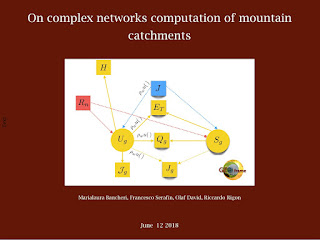If you are interested in the hydraulics of plants, you should give a look to the recent production of Anke Hildebrandt. Her production encounter my favor since she is able to put together experimental work and theoretical work on the thermodynamics of trees. A topic on which recently I became interested in. Relevant among her production is the work on hess: A thermodynamic fomulation of root water uptake which was awarded as one of the best paper of 2017 in HESS. No more comments. Just papers to read below.
Recent papers
Van Stan, J. T., Norman, Z., Meghoo, A., Friesen, J., Hildebrandt, A., Côté, J.-F., et al. (2017). Edge-to-Stem Variability in Wet-Canopy Evaporation From an Urban Tree Row. Boundary-Layer Meteorology, 165(2), 295–310.
http://doi.org/10.1007/s10546-017-0277-7 Guderle, M., Bachmann, D., Milcu, A., Gockele, A., Bechmann, M., Fischer, C., et al. (2017). Dynamic niche partitioning in root water uptake facilitates efficient water use in more diverse grassland plant communities. Functional Ecology, 32(1), 214–227.
http://doi.org/10.1111/1365-2435.12948 Metzger, J. C., Wutzler, T., Dalla Valle, N., Filipzik, J., Grauer, C., Lehmann, R., et al. (2017). Vegetation impacts soil water content patterns by shaping canopy water fluxes and soil properties. Hydrological Processes, 31(22), 3783–3795.
http://doi.org/10.1002/hyp.11274 Weisser, W.W., C. Roscher, S. Meyer, A. Ebeling, G. Luo, E. Allan, H. Beßler, R. Barnard, N. Buchmann, F. Buscot, C. Engels, C. Fischer, M. Fischer, A. Gessler, G. Gleixner, S. Halle, A. Hildebrandt, H. Hillebrand, H. de Kroon, M. Lange, S. Leimer, X. Le Roux, A. Milcu, L. Mommer, P. Niklaus, Y. Oelmann, R. Proulx, C. Scherber, M. Scherer-Lorenzen, S. Scheu, T. Tscharntke, M. Wachendorf, C. Wagg, A. Weigelt, W. Wilcke, E.-D. Schulze, B. Schmid, N. Eisenhauer. Biodiversity effects on ecosystem functioning in a 14-year grassland experiment: patterns, mechanisms, and open questions. Basic and Applied Ecology, doi: 10.1016/j.baae.2017.06.002. (
link)
Zimmermann, A., Voss, S., Metzger, J. C., Hildebrandt, A., & Zimmermann, B. (2016). Capturing heterogeneity: The role of a study area’s extent for estimating mean throughfall. Journal of Hydrology, 542(C), 781–789.
http://doi.org/10.1016/j.jhydrol.2016.09.047 Guderle, M., D. Bachmann, A. Milcu, A. Gockele, M. Bechmann, C. Fischer, C. Roscher, D. Landais, O. Ravel, S. Devidal, J. Roy, A. Gessler, N. Buchmann, A. Hildebrandt. Dynamic niche partitioning in root water uptake facilitates efficient water use in more diverse plant communities. Functional Ecology, doi: 10.1111/1365-2435.12948. (
link)
Metzger, J. C., N. Dalla Valle, T. Wutzler, J. Filipzik, R. Lehmann, M. Roggenbuck, D. Schelhorn, J. Weckmüller, K. Küsel, K. U. Totsche, S. Trumbore, A. Hildebrandt. Tracing spatial variation of canopy water fluxes to the soil with high resolution data. Hydrological Processes. doi: 10.1002/hyp.11274 (
link)
Arnold, S., Attinger, S., Frank, K., Hildebrandt, A. 2016. Assessing the structural adequacy of alternative ecohydrological models using a pattern-oriented approach. Ecological Modelling 316: 52-61. doi: doi:10.1016/j.ecolmodel.2015.08.003. (
link)
Hildebrandt, A. A. Kleidon and M. Bechmann. A thermodynamic fomulation of root water uptake. Hydrology and Earth System Sciences. 20:
3441-3454, doi: 10.51947hess-20-3441-2016. (
link)
Milcu, A., W. Eugster, D. Bachmann, M. Guderle, Ch. Roscher, D. Landais, O. Ravel, A. Gessler, M. Lange, A. Ebeling, W. Weisser, J. Roy, A. Hildebrandt, N. Buchmann. 2015. Plant species and functional diversity increase grassland productivity-related water vapour fluxes: a combined Ecotron and modeling approach. Ecology 97(8): 2044-2054. doi: 10.1890/15-1110.1 (
link)
Renner, M., S. K. Hassler, T. Blume, M. Weiler, A. Hildebrandt, M. Guderle, S. J. Schymanski, and A. Kleidon. Dominant controls of transpiration along a hillslope transect inferred from ecohydrological measurements and thermodynamic limits, Hydrology and Earth System Sciences 20: 2063-2083. doi: 10.5194/hess-20-2063-2016. (
link)
Fischer, C., Tischer, J., Roscher, C., Eisenhauer, N., Ravenek, J. M., Gleixner, G., Attinger, S., Jensen, B., de Kroon, H., Mommer, L., Scheu, S., Hildebrandt, A. 2015. Plant species diversity affects infiltration capacity in an experimental grassland through changes in soil properties. Plant and Soil. 397(1): 1-16, doi: 10.1007/s11104-014-2373-5 (
link)
Guderle M. and Hildebrandt A. 2015. Using measured soil water contents to estimate evapotranspiration and root water uptake profiles - a comparative study. Hydrology and Earth System Sciences. 19: 409-425. doi: 10.5194/hess-19-409-2015 (
link)
Bechmann, M., C. Schneider, A. Carminati, D. Vetterlein, S. Attinger, A. Hildebrandt. 2014. Parameterizing complex root water uptake models - the arrangement of root hydraulic properties within the root architecture affects dynamics and efficiency of root water uptake. Hydrology and Earth System Sciences. 18:
4189-4206. doi: 10.5194/hess-18-4189-2014 (
link)
Fischer, C., C. Roscher, Jensen, N. Eisenhauer, J. Baade, S. Attinger, S. Scheu, W.W. Weisser, A. Hildebrandt. 2014. How do earthworm, soil texture and plant composition affect infiltration in managed grasslands along a plant diversity gradient? PLoS ONE9(6): e98987. doi:10.1371/journal.pone.
0098987. (link)
Leimer, S., Kreutziger, Y., Rosenkranz, S., Beßler, H., Hildebrandt, A., Oelmann, Y., Weisser, W., Wirth, C. Wilcke, W., 2014. Plant diversity effects on the water balance of an experimental grassland. Ecohydrology, doi: 10.1002/eco.1464. (
link)
Carminati, A., C. L. Schneider, A. B. Moradi, M. Zarebanadkouki, D. Vetterlein, H.-J. Vogel, A. Hildebrandt, U. Weller, L. Schüler, and S. E. Oswald. 2011. How the Rhizosphere May Favor Water Availability to Roots. Vadose Zone Journal 10:988. doi: 10.2136/vzj2010.0113. (
link)
Kalbacher, T., C. L. Schneider, W. Wang, A. Hildebrandt, S. Attinger, and O. Kolditz. 2011. Modeling Soil-Coupled Water Uptake of Multiple Root Systems with Automatic Time Stepping. Vadose Zone Journal 10:727. doi: 10.2136/vzj2010.0099. (
link)
Alexandrov, G. a., D. Ames, G. Bellocchi, M. Bruen, N. Crout, M. Erechtchoukova, A. Hildebrandt, F. Hoffman, C. Jackisch, and P. Khaiter. 2010. Technical assessment and evaluation of environmental models and software: Letter to the Editor. Environmental Modelling & Software 26:328-336. doi: 10.1016/j.envsoft.2010.08.004. (
link)


























